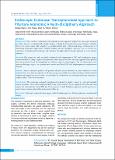Please use this identifier to cite or link to this item:
https://hdl.handle.net/20.500.14356/1672Full metadata record
| DC Field | Value | Language |
|---|---|---|
| dc.contributor.author | Regmi, Deepak | - |
| dc.contributor.author | Thapa, Amit | - |
| dc.contributor.author | KC, Bidur | - |
| dc.contributor.author | Shakya, Bikram | - |
| dc.date.accessioned | 2023-05-18T06:05:26Z | - |
| dc.date.available | 2023-05-18T06:05:26Z | - |
| dc.date.issued | 2017 | - |
| dc.identifier.citation | RegmiD., ThapaA., KCB., & ShakyaB. (2017). Endoscopic Endonasal Transsphenoidal Approach to Pituitary Adenoma: A Multi-disciplinary Approach. Journal of Nepal Health Research Council, 15(2), 174-177. https://doi.org/10.33314/jnhrc.v15i2.1009 | en_US |
| dc.identifier.issn | Print ISSN: 1727-5482; Online ISSN: 1999-6217 | - |
| dc.identifier.uri | http://103.69.126.140:8080/handle/20.500.14356/1672 | - |
| dc.description | Original Article | en_US |
| dc.description.abstract | Abstract Background: The excellent visualization and minimally invasive approach employed in endoscopic endonasal procedures has now revolutionized the pituitary surgery, replacing the transnasal microscopic technique worldwide. However, it involves major shift in hand-eye co-ordination from static 3 dimensional images of microscope to 2 dimensional endoscopic images hence demands training and inter-disciplinary approach. Here we present our experiences in learning and developing a safe endonasal transsphenoidal endoscopic approach to resect pituitary adenomas. Methods: This prospective study was jointly conducted in the departments of ENT and Neurologicals surgery Kathmandu Medical College, Nepal, from September 2014 to August 2016. The endoscopic approach to the sphenoid sinus was performed by an Otolaryngologist and ablative surgery by Neurosurgeon. The ease of procedure, intra operative challenges, surgical cure, post-operative cerebro spinal fluid (CSF) leaks and postoperative complaints were analyzed. Results: Sixteen consecutive patients with pituitary adenoma (macro adenoma=13, micro adenoma =3) were analyzed. There were three intraoperative CSF leak, managed successfully. Two patients developed transient diabetes insipidus and surgical cure rate was 90%. No case had to be switched over to traditional microscopic route due to technical failure. There was no mortality. Conclusions: The endoscopic endonasal transsphenoidal approach to pituitary tumors is a safe and minimally invasive procedure, which can be employed safely in any of our centers in Nepal, equipped with endoscopic sinus surgery and endoscopically trained ENT and Neurosurgeons. A multi disciplinary approach provides good access, greater tumor excision and excellent postoperative follow up. Keywords: Endoscopic; minimal invasive surgery;multi-disciplinary approach; Pituitary adenoma; transsphenoidal surgery. | en_US |
| dc.language.iso | en | en_US |
| dc.publisher | Nepal Health Research Council | en_US |
| dc.relation.ispartofseries | May-Aug, 2017;1009 | - |
| dc.subject | Endoscopic | en_US |
| dc.subject | Minimal invasive surgery | en_US |
| dc.subject | Multi-disciplinary approach | en_US |
| dc.subject | Pituitary adenoma | en_US |
| dc.subject | Transsphenoidal surgery | en_US |
| dc.title | Endoscopic Endonasal Transsphenoidal Approach to Pituitary Adenoma: A Multi-disciplinary Approach | en_US |
| dc.type | Journal Article | en_US |
| Appears in Collections: | Vol 5 No 2 Issue 36 May-Aug 2017 | |
Files in This Item:
| File | Description | Size | Format | |
|---|---|---|---|---|
| 1009-Article Text-2333-1-10-20170908.pdf | Fulltext Download | 169.6 kB | Adobe PDF |  View/Open |
Items in DSpace are protected by copyright, with all rights reserved, unless otherwise indicated.
